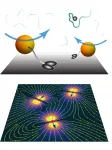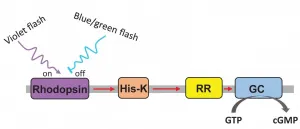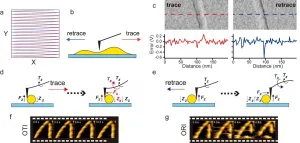How cells transport molecules with 'active carpets'
New research provides insights into the process of diffusion in living systems, with implications from novel active coatings to understanding how pathogens are cleared from lungs.
2021-03-29
(Press-News.org) A drop of food coloring slowly spreading in a glass of water is driven by a process known as diffusion. While the mathematics of diffusion have been known for many years, how this process works in living organisms is not as well understood.
Now, a study published in Nature Communications provides new insights on the process of diffusion in complex systems. The result of a collaboration between physicists at Penn, the University of Chile, and Heinrich Heine University Düsseldorf, this new theoretical framework has broad implications for active surfaces, such as ones found in biofilms, active coatings, and even mechanisms for pathogen clearance.
Diffusion is described by Fick's laws: Particles, atoms, or molecules will always move from a region of high to low concentration. Diffusion is one of the most important ways that molecules move within the body. However, for the transport of big objects over large distances, standard diffusion becomes too slow to keep up.
"That's when you need active components to help transport things around," says study co-author Arnold Mathijssen. In biology, these actuators include cytoskeletal motors that move cargo vesicles in cells, or cilia that pump liquid out of human lungs. When many actuators accumulate on a surface, they are known as "active carpets." Together, they can inject energy into a system in order to help make diffusion more efficient.
Mathijssen, whose research group studies the physics of pathogens, first became interested in this topic while studying biofilms with Francisca Guzmán-Lastra, an expert on the physics of active matter, and theoretical physicist Hartmut Löwen. Biofilms are another example of active carpets since they use their flagella to create "flows" that pump liquid and nutrients from their environment. Specifically, the researchers were interested in understanding how biofilms are able to sustain themselves when access to nutrients is limited. "They can increase their food uptake by creating flows, but this also costs energy. So, the question was: How much energy do you put in to get energy out?" says Mathijssen.
But studying active carpets is difficult because they don't align neatly with Fick's laws, so the researchers needed to develop a way to understand diffusion in these non-equilibrium systems, or ones that have added energy. "We thought that we could generalize these laws for enhanced diffusion, when you have systems that do not follow Fick's laws but may still follow a simple formula that is widely applicable to many of these active systems," Mathijssen says.
After figuring out how to connect the math needed to understand both bacterial dynamics and Fick's laws, the researchers developed a model similar to the Stokes-Einstein equation, which describes the relationship with temperature and diffusion, and found that microscopic fluctuations could explain the changes they saw in particle diffusion. Using their new model, the researchers also found that the diffusion generated by these small movements is incredibly efficient, allowing bacteria to use just a small amount of energy to gain a large amount of food.
"We've now derived a theory that predicts the transport of molecules inside cells or close to active surfaces. My dream would be that these theories would be applied in different biophysical settings," says Mathijssen. His new research lab at Penn will start working on follow-up experiments to test out these new models. They plan to study active diffusion both in biological and engineered microscopic systems.
Mathijssen, who is also involved on a project related to the spread of COVID-19 in food-processing facilities, says that the cilia in lungs are another important example of active carpets in biology, especially since they serve as the first line of defense against pathogens like COVID-19. He says, "That would be another very important thing to test, whether this theory of active carpets may be linked to the theory of pathogen clearance in the airways."
INFORMATION:
This research was supported by the United States Department of Agriculture (USDA-NIFA AFRI grants 2020-67017-30776 and 2020-67015-32330) and Human Frontier Science Program Fellowship LT001670/2017 and an International Research Travel Award from the American Physical Society.
[Attachments] See images for this press release:

ELSE PRESS RELEASES FROM THIS DATE:
2021-03-29
BUFFALO, N.Y. - Bullying at boarding schools has a negative impact on students' emotional health, but for male students, having a school staff member to rely on for support may mute the harmful effects of bullying, according to a new University at Buffalo study. Support networks did not have the same effect for female students, the researchers say.
The study, recently published in School Psychology Review, is one of few to examine the impact of bullying at boarding schools, which provide a unique environment where most students live on school grounds, away from their families. It is also one of the first studies to observe the effects ...
2021-03-29
Climate labels informing us of a meat product's carbon footprint cause many people to opt for climate-friendlier alternatives. This applies to people who are curious about a product's carbon footprint, as well as to those who actively avoid wanting to know more. The finding is published in a new study from, among others, the University of Copenhagen. As such, climate labeling food products can be a good way of reducing our climate footprint. But according to the researcher behind the study, labels must be obligatory for them to be effective.
Certain situations exist where we humans strategically avoid greater knowledge and more information - a phenomenon known as "active information avoidance". ...
2021-03-29
The unicellular green alga Chlamydomonas reinhardtii has already given research a massive boost: One of its light sensors, channelrhodopsin-2, founded the success of optogenetics about 20 years ago.
In this technology, the alga's light sensor is incorporated into cells or small living organisms such as threadworms. Afterwards, certain physiological processes can be triggered or stopped by light. This has already led to several new scientific findings, for example on the function of nerve cells.
Now the green alga Chlamydomonas is once again setting an accent. Once again, it is its light sensors, ...
2021-03-29
High-speed atomic force microscopy (HS-AFM) is an imaging technique that can be used for visualizing biological processes, for example the activity of proteins. Nowadays, typical HS-AFM frame rates are as high as 12 frames per second. In order to improve the capabilities of the method, so that it can be applied to an ever expanding range of biological samples, better video rates are needed, though. Moreover, faster recording times imply less interaction between the sample and the probe -- a tip scanning the sample's surface -- making the imaging ...
2021-03-29
A team of researchers, led by the Instituto de Ciencias del Patrimonio (Incipit-CSIC) and the Instituto de Astrofísica de Canarias (IAC), in collaboration with the team from the Arqueological Zone of Caral (Perú) led by Dr. Ruth Shady Solís, has established the relation between the position of the monuments of the Supe Culture (Perú), their orientations, and some astronomical and topographic features, which opens the way to the analysis of the way the inhabitants of this valley conceived space and time 5000 years ago. The results of the study have just been published in the journal Latin American Antiquity.
The valley of the river Supe in Perú contains the first evidence for city building in the Americas. In recent decades in this valley and ...
2021-03-29
Next-gen electronics is envisioned to be non-rigid, component-free, flexible, bendable, and easily integrable with different objects.
Direct-write printing techniques provide unique opportunity to enable this vision through use of nanomaterial so-called functional inks, that can be tailored to add desired functionalities on various flexible substrates, such as textiles or plastic.
The technology, known as Printed Electronics (PE), has been known for decades, but has recently gained considerable attention due to innovation in material inks, process technology and design revolution.
To keep the research community abreast with the latest technological advancements in the area of droplet-based PE techniques for next-gen devices, researchers from Aarhus University have now ...
2021-03-29
Kanazawa, Japan - Solar cells are excellent renewable energy tools that use sunlight to drive an electrical current for power. They've been used to power homes since the 1980s, and their performance and production cost have improved dramatically since then. The most common solar cells, based on silicon, work well for a long time. They retain more than 80% of their functionality even after 25 years. However, the efficiency--i.e., how much of the incoming sunlight is converted to electrical power--of commercial-scale silicon solar cells is currently only around 20%.
Maximizing solar cells' energy conversion efficiency will improve their competitiveness compared to fossil fuels and help optimize them as a sustainable ...
2021-03-29
The B.1.1.7 and B.1.351 variants of SARS-CoV-2 were first detected in the UK and South Africa respectively, and have since spread to many other countries. Scientists from the Institut Pasteur joined forces with Orléans Regional Hospital, Tours University Hospital, Créteil Intercommunal Hospital, Strasbourg University Hospital and Georges Pompidou European Hospital to study the sensitivity of these two variants to neutralizing antibodies present in the serum samples of people who have been vaccinated or previously infected with SARS-CoV-2. They compared this sensitivity with that of the reference ...
2021-03-29
Whether for microscopy, data storage or sensor technology, many advanced technological applications that require specific functions rely on the structure of the electromagnetic field near the surfaces of materials. In nanosystems, so-called surface phonons, i.e. temporal distortions of the atomic lattice, contribute decisively to the physical and thermodynamic properties.
If surface phonons could be specifically manipulated, it would be possible to achieve better thermal conduction or heat transfer between two components with nanosurfaces. This could be used, for example, in detectors, sensors or in highly efficient passive cooling systems. In addition, surface phonons concentrate electromagnetic energy ...
2021-03-29
A paper by the Kavli Institute for the Physics and Mathematics of the Universe (Kavli IPMU) Director Ooguri Hirosi and Project Researcher Matthew Dodelson on the string theoretical effects outside the black hole photon sphere has been selected for the "Editors' Suggestion" of the journal Physical Review D. Their paper was published on March 24, 2021.
In a quantum theory of point particles, a fundamental quantity is the correlation function, which measures the probability for a particle to propagate from one point to another. The correlation function develops singularities when the two points are connected by light-like trajectories. In a flat spacetime, there is such a unique trajectory, but when spacetime is curved, there ...
LAST 30 PRESS RELEASES:
[Press-News.org] How cells transport molecules with 'active carpets'
New research provides insights into the process of diffusion in living systems, with implications from novel active coatings to understanding how pathogens are cleared from lungs.






